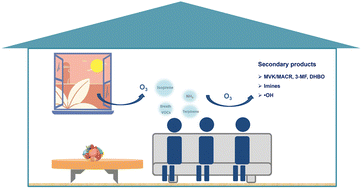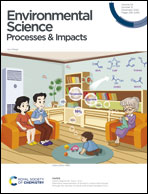Real-time measurements of product compounds formed through the reaction of ozone with breath exhaled VOCs†
Abstract
Human presence can affect indoor air quality because of secondary organic compounds formed upon reactions between gaseous oxidant species, e.g., ozone (O3), hydroxyl radicals (OH), and chemical compounds from skin, exhaled breath, hair and clothes. We assess the gas-phase product compounds generated by reactions of gaseous O3 with volatile organic compounds (VOCs) from exhaled human breath by real time analysis using a high-resolution quadrupole-orbitrap mass spectrometer (HRMS) coupled to a secondary electrospray ionization (SESI) source. Based on the product compounds identified we propose a reaction mechanism initiated by O3 oxidation of the most common breath constituents, isoprene, α-terpinene and ammonia (NH3). The reaction of O3 with isoprene and α-terpinene generates ketones and aldehydes such as 3,4-dihydroxy-2-butanone, methyl vinyl ketone, 3-carbonyl butyraldehyde, formaldehyde and toxic compounds such as 3-methyl furan. Formation of compounds with reduced nitrogen containing functional groups such as amines, imines and imides is highly plausible through NH3 initiated cleavage of the C–O bond. The detected gas-phase product compounds suggest that human breath can additionally affect indoor air quality through the formation of harmful secondary products and future epidemiological studies should evaluate the potential health effects of these compounds.

- This article is part of the themed collections: Environmental exposure and impacts, Environmental Science: Processes & Impacts Recent HOT Articles and Indoor Air Quality


 Please wait while we load your content...
Please wait while we load your content...